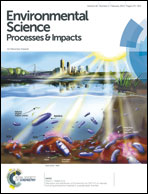Investigation of organic matter migrating from polymeric pipes into drinking water under different flow manners†
Abstract
Polymeric pipes, such as unplasticized polyvinyl chloride (uPVC) pipes, polypropylene random (PPR) pipes and polyethylene (PE) pipes are increasingly used for drinking water distribution lines. Plastic pipes may include some additives like metallic stabilizers and other antioxidants for the protection of the material during its production and use. Thus, some compounds can be released from those plastic pipes and cast a shadow on drinking water quality. This work develops a new procedure to investigate three types of polymer pipes (uPVC, PE and PPR) with respect to the migration of total organic carbon (TOC) into drinking water. The migration test was carried out in stagnant conditions with two types of migration processes, a continuous migration process and a successive migration process. These two types of migration processes are specially designed to mimic the conditions of different flow manners in drinking water pipelines, i.e., the situation of continuous stagnation with long hydraulic retention times and normal flow status with regular water renewing in drinking water networks. The experimental results showed that TOC release differed significantly with different plastic materials and under different flow manners. The order of materials with respect to the total amount of TOC migrating into drinking water was observed as PE > PPR > uPVC under both successive and continuous migration conditions. A higher amount of organic migration from PE and PPR pipes was likely to occur due to more organic antioxidants being used in pipe production. The results from the successive migration tests indicated the trend of the migration intensity of different pipe materials over time, while the results obtained from the continuous migration tests implied that under long stagnant conditions, the drinking water quality could deteriorate quickly with the consistent migration of organic compounds and the dramatic consumption of chlorine to a very low level. Higher amounts of TOC were released under the continuous migration tests.


 Please wait while we load your content...
Please wait while we load your content...